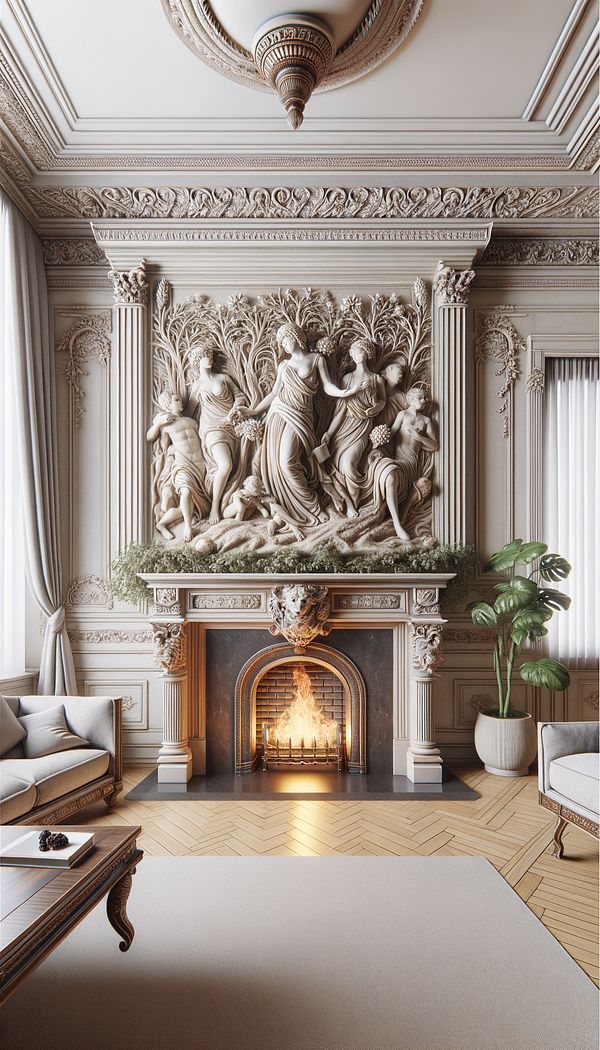What is a High Relief?
High relief is a sculptural technique where the sculpted elements stand out significantly from the background.
Description
High relief, or alto-relievo, is an expressive, three-dimensional sculptural technique utilized in various art and design disciplines, including interior design. Unlike its counterpart, low relief (or bas-relief), where the design barely stands out from the background, high relief projects boldly, creating a dramatic, eye-catching effect. This approach can add depth and intensity to the visual storytelling of a space, transforming flat surfaces into vivid scenes or decorative motifs.
In interior design, high relief is often found on walls, furniture, doors, and fireplace mantels, where sculpted elements such as figures, foliage, or abstract shapes emerge from the surface, sometimes appearing almost fully in the round. The technique can be applied using a range of materials, including plaster, wood, stone, and metal, each adding a different texture and depth to the artwork. High relief can introduce a layer of luxury and sophistication to a space, embodying craftsmanship and artistic expression.
Integrating high relief into a space requires a thoughtful approach to balance and composition, as these sculptural elements can command significant visual attention. It's crucial to consider the scale, theme, and material of the high relief in relation to the overall interior design scheme to ensure a harmonious and impactful presence.
Usage
High relief is often seen in classical and neoclassical interiors, adorning the walls of grand entrance halls or the panels of luxurious furniture pieces. However, it is also embraced in modern and eclectic design schemes, where a single high relief piece can serve as a bold focal point in a minimalist room or add a touch of historical elegance to a contemporary setting.
FAQs
-
How does high relief differ from low relief?
High relief projects significantly from its background, often appearing almost fully in the round, which creates a more dramatic and three-dimensional effect compared to low relief, where the sculpted design barely stands out from the background.
-
What materials are commonly used for high relief?
High relief can be created using a variety of materials, including plaster, wood, stone, and metal. The choice of material influences the texture, depth, and overall aesthetic of the piece.
-
Where is high relief typically installed in interior design?
High relief is commonly installed on walls, furniture, doors, and fireplace mantels, serving as decorative elements that add depth and visual interest to a space.
-
Can high relief be incorporated into modern interior design?
Yes, high relief can be integrated into modern and eclectic interior design schemes, where it can serve as a striking focal point or add a layer of historical elegance.
Practical Application
When incorporating high relief into an interior design project, consider the piece's scale, theme, and material in relation to the room's overall aesthetic. Balance is key; a high relief element should complement, not overwhelm, the space. Ensure adequate lighting to highlight the sculpted details and enhance the three-dimensional effect. High relief can be a powerful tool in creating a unique and sophisticated interior, but it requires careful planning and integration.
-
Architectural Elements199 articles
-
Design Styles478 articles
-
Decorative Techniques322 articles
-
Art & Sculpture30 articles
-
Fabrication & Craftsmanship133 articles
-
Floor PlanA floor plan is a scale drawing that presents the layout of a space from above.
-
GuillocheGuilloche is a decorative technique involving intricate, interlacing patterns.
-
Tongue & GrooveTongue & Groove is a method of fitting similar objects together, edge to edge.
-
SouthwesternSouthwestern refers to a design style influenced by the characteristics and cultures of the American Southwest.
-
FillFill refers to materials used to provide softness, volume, or insulation in interior design elements.
